Listen to GardenLine Radio Nov. 8!
November 5, 2014 by admin
Filed under In the News, Shade Gardening

I’ll be a guest of GardenLine radio host C.L. Fornari (shown here) this Saturday, Nov. 8, 8:00-10:00 am. Please call in with your questions!
I’m excited to be doing my first-ever radio interview this coming Saturday, November 8! I’ll be a guest of long-time radio host C.L. Fornari, whose show GardenLine airs on WXTK 95.1 FM out of Cape Cod on Saturdays from 8:00 am to 10:00 a.m. in the Eastern time zone.
Not in WXTK’s broadcast area? You can hear it live-streamed at the WXTK website. From the home page, click on “Listen Live” in the upper right-hand corner (and be sure to turn your sound up!).
This is a live, call-in show, so if you have any gardening questions for me (or C.L.), dial (888) 998-5951 or (508) 775-9985 on Saturday morning and talk to us. We’ll be following your lead, and this would be a great opportunity to get more information about any topic in The Shady Lady’s Guide to Northeast Shade Gardening that you wish I’d covered in more detail!
In addition, I’m hoping we’ll get to a few things that have been on my mind lately, such as this thought that I shared with C.L. a few weeks ago:
“I have found that over time my entire thought process about gardening has shifted dramatically. I rarely think of plants in terms of “like” or “dislike,” for instance; instead, I think about what the plant is capable of doing. Basically, I focus on a plant’s strengths rather than my subjective reaction to it. I see gardening largely as a problem-solving exercise.”
So, whether you’re trying to solve a gardening problem or want to share one of your own solutions, please join us! I’m looking forward to talking with you then.
Plants Are Not Created Equal
March 12, 2014 by admin
Filed under Garden Design, Perennials, Regional Gardening, Shade Gardening
Over the coming months I’ll be basing a number of blog posts, including this one, on material from my forthcoming book, The Shady Lady’s Guide to Northeast Shade Gardening. The official publication date is May 6, 2014. You can learn more about the book here, here and here.
In my last blog post I talked about a process of elimination I think gardeners should use in order to choose perennial plants for their gardens and why I believe that process will result in the best choices. The rationale behind it can be boiled down to a few simple words: plants are not created equal—at least not from an ornamental gardening standpoint. Some are much better garden performers than others.
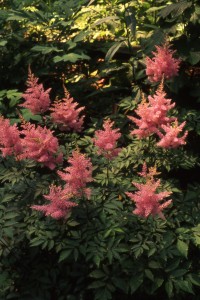
Astilbe is an excellent example of a backbone plant: it looks good all season and doesn't require tons of work.
It’s also important to realize that there’s no such thing as an ideal plant. You should no more expect perfection from a plant than a person, so you may have to give a little when it comes to your preferences.
Looking back at all the questions I said you should ask yourself when considering plants for your garden, I want to be clear that I’m not telling you there’s any plant for which all the answers will be what you want them to be. I’m just saying that for some plants a lot more of those questions have good answers, and those are the ones you should use to fill most of the space in your shade garden.
In fact, I have a name for these superior garden candidates: “backbone” plants. These are ornamentals whose exceptional qualities make them the best choices for filling the majority of the space in your garden. If you use them in abundance, they’ll hold your garden together and keep it solid, like a spine supports a body. Everything else, to one degree or another, is filler.
Strive to use backbone plants for at least 75-80% of your garden. Actually, you could build your garden from nothing but backbone plants, but for the sake of variety, you may allocate 15-20% of the space to secondary, filler plants that I refer to as “accent” plants. Finally, you can devote 5-10% of the space to a few annuals or tender perennials if you really feel the need to have them.
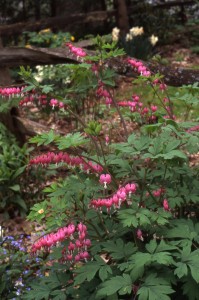
Old-fashioned bleeding heart is certainly a pretty face, but without staying power it doesn't qualify as a backbone plant.
So, what are some examples of backbone plants? I’ll give you two examples of backbone shade plants here, although this process of categorizing plants by their ability (or not) to deliver long-season performance applies equally well to sun as to shade.
The astilbe pictured above is a great example of a backbone shade perennial. It has strong, prominent flowers and attractive foliage, it’s not incredibly picky about growing conditions, it doesn’t require a lot of care, and it isn’t invasive. For those of us in the Northeast, its admirable cold hardiness is an essential quality, and the fact that deer generally ignore it is a godsend. Its only shortcoming is that it
really only flowers well in light shade at northern latitudes; in deep
shade, flowering will be minimal.
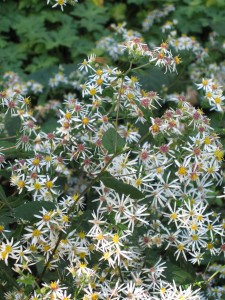
White wood aster is an underappreciated but very fine native backbone plant.
Plants like astilbe and white wood aster are reliable and unfussy—like friends who are easy to be with and always come through in a pinch. But you’ll notice that neither one gets “perfect marks.” As I pointed out earlier, it will almost never be the case that a plant perfectly suits all your needs and desires.
And they are not no-maintenance plants—there is no such thing in a garden setting. Each one has a rather predictable growth habit or behavior that will eventually demand your attention—astilbes often want division every few years, while white wood aster will migrate and have to be kept in bounds—but neither one will require an onerous amount of work. What they offer is a high likelihood of being successful additions to your garden, delivering steady results through the years while not making you regret ever planting them.
I know that this way of thinking about plants and plant selection may seem novel or even backwards to many readers. Gardeners are inundated with the message that gardening is all about personalizing your space and expressing your taste, not to mention the message that it should be cheap and easy, to boot (it generally isn’t, but that’s a topic for another blog post). While it’s certainly true that your garden should reflect your individuality, focusing too much on that obscures some inconvenient facts. Successful gardening means finding a manageable way to get good results given your budget of time and money, and for most homeowners that means putting functionality first.
I hope I’ve persuaded you of the value of using my approach. If you need a little more convincing, consider this: in the early years of my ornamental gardening experimentation, I bought a lot of plants I liked a lot and proceeded to…kill them. Mostly—because I was trying to determine the limits of their shade tolerance—I subjected them to inadequate light, and of course, a lot of them expired.
I feel kind of guilty about it now, but all that “horticide” did have a point: those sacrificial plants eventually taught me to categorize a wide range of shade perennials by both their needs and their performance potential for gardeners. In the process, I came to appreciate a whole new palette of plants for their ability to tough out the difficult conditions we Northeast shade gardeners face.
In my upcoming book, The Shady Lady’s Guide to Northeast Shade Gardening, I elaborate on the topic of what makes a superior shade garden perennial and how to use a wide range of shade plants to good effect. I hope that knowledge will help you find the best choices for your particular situation.
How (Not) to Pick a Plant
February 6, 2014 by admin
Filed under Garden Design, Perennials, Shade Gardening
Over the coming months I’ll be basing a number of blog posts, including this one, on material from my forthcoming book, The Shady Lady’s Guide to Northeast Shade Gardening. The official publication date is May 6, 2014. You can learn more about the book here, here and here.
When you pick perennial plants to put in your shade garden, how do you do it? Most people would start out by picking plants they like—and that’s where they’d make their first, and worst, mistake.
Huh? What? Surely I can’t be advising you to pick out plants you don’t like?! No, of course not. But think about this for a second. When you go shopping for a new car, do you just pick out the one you like the best? No—at least not if you’re like most of us. If that were all it took, we’d all be driving around in Ferraris and Lamborghinis. The problem with that approach is that most sports cars won’t do what most people need a car to do: get up a snowy hill on a winter day and deliver you to your job in one piece, or get enough miles to the gallon to not break the fuel budget.
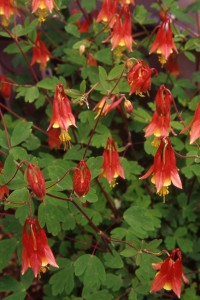
Flowers, flowers, we all like flowers—but there are many other important things to consider when choosing shade perennials.
In other words, we consider practical things. As weird an idea as this will seem to many people, you should do the same thing when you pick out plants—if you want your garden to look good with minimal effort and expense for the longest possible season.
Not all plants are equally good at doing that. In fact, for any given type of garden in any given region, only a small number of plants will give that kind of superior performance, in the same way that, in all likelihood, only a small number of cars will satisfy your criteria for budget and functionality.
So, what are the practical questions you have to ask when picking out plants? First, the more obvious ones:
• Is the plant cold hardy where I live?
• Does the plant prefer the conditions I can offer it?
It’s self-evident why these are questions you should ask first. It makes little sense to populate your perennial garden with plants that won’t be, well, perennial in your area. It also makes little sense to invest in plants that won’t be happy with the growing conditions you provide them. Matching plants to growing conditions is an essential part of the art of garden design. I’m not going to go into detail here about the fine points of that process; what matters is that you realize its importance.
What else do you need to ask yourself in order to pick the best perennials for shade? Here are a few more:
• Is the plant disease resistant?
• Is the plant prone to insect infestation?
• Is the plant unpalatable to deer and other potential browsers?
• Does the plant spread or seed aggressively?
• Does the plant typically go dormant before first frost?
• Does the plant have foliage that looks good all season long?
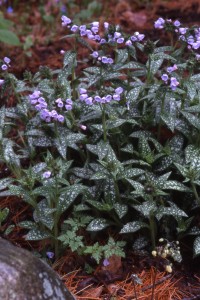
Powdery-mildew resistant Pulmonaria 'Roy Davidson'
The benefits of disease and pest resistance are obvious. Lungworts (Pulmonaria, see photo at left), for example, have unique speckled foliage that can brighten shady nooks and crannies, but most of them are prone to a disfiguring fungal disease called powdery mildew that leaves them coated with an unattractive whitish film. Luckily, some lungworts are resistant. If you buy only the resistant ones, you’ll be able to enjoy the beauty of disease-free lungworts, and you won’t have to expend extra effort to keep them that way.
It’s the same story for all the other questions above. By carefully selecting plants that aren’t palatable to most insect pests and browsing animals, you eliminate the need to take action to stop various critters from nibbling. Likewise, you reduce the need for work (and increase the percentage of your time in the garden devoted to enjoying it) by avoiding overly aggressive spreading plants.
Finally, as a general rule plants that perform well over a long season should be given priority over those that go dormant early or whose foliage declines in quality after flowering. Obviously, we’d all prefer a garden that looks full and good for the longest possible stretch of time.
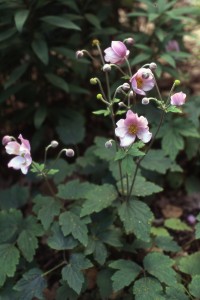
The long-flowering Japanese anemone cultivar 'Robustissima'
• Does the plant have attractive, prominent flowers? (Finally!)
• Do the flowers have a scent that’s nice, objectionable or simply absent?
• Do the flowers last a long time?
And there you have it: questions about flowers are in last place. Now, I want to clarify something. I understand perfectly why so many home gardeners give in to the temptation to fill their properties with plants having beautiful flowers. Beautiful flowers are lovely to look at—it’s as simple as that. The problem is that we don’t live in an ideal world. Flowers fade, and most perennials only produce flowers for two to three weeks every year under the best of circumstances. That’s not very long, so if you pick plants based on how well you like their flowers, you won’t get much bang for your buck.
I’m not saying that you should ignore a plant’s flowers when making choices. For instance, it is true that a small number of perennials will flower for a longer-than-average time, and can be worthwhile making room for these plants in your garden for that simple reason. One example is the Japanese anemone pictured above. I’m just saying that most of the time you should only be considering the flowers of plants that have passed muster in a lot of other ways first. Flowers should be your last consideration, not your first.
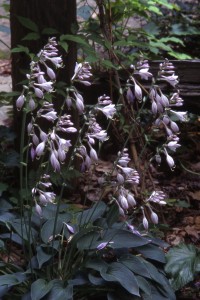
Cut these hosta flowers off? Not me!
In my next blog post, I’ll elaborate a little more on what makes a superior shade perennial and share a few examples.
Plants for Shade Containers
May 28, 2012 by admin
Filed under Container Gardening, Shade Gardening
A year ago I blogged about the subject of my Containers that Won’t Quit lecture, which is how to compose containers that will look as good in September as they do in June. That prompted a request for a post recommending great shade tolerant plants for containers. In my area, Memorial Day weekend is when it’s considered “safe” (reliably free from frost) to plant annuals and tender perennials, so it’s often when people plant their containers. In light of that, here are some recommendations—annual and otherwise—for your shade containers.
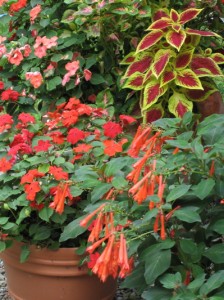
Color-coordinated fuchsia, gold-margined coleus and impatiens in containers
Your options for attractive compositions will expand considerably if you’re willing to use plenty of colorful foliage and not restrict yourself to flowering plants. Interestingly, many of the best plants for this purpose are things you might already know as houseplants or hardy perennials.
Second, a rule of thumb: In shade, gold rules. That is, no color shows up in the shadows better than gold—not even white. Creeping Jenny (Lysimachia nummularia ‘Aurea’) is a fast-growing plant whose long stems bearing bright, penny-shaped leaves will trail beautifully over the sides of containers. It’s sold as an annual in garden centers in spring, but it’s actually a perennial supposedly hardy to USDA Zone 3, and I can say for sure it’s hardy here in Zone 5. I’d also try cultivars of the perennial grass Hakonechloa macra, which has a lax, compact and clumping habit. ‘Aureola’ and ‘All Gold’ are two choices that will give you a bright splash of virtual sunshine to light up shady spaces.
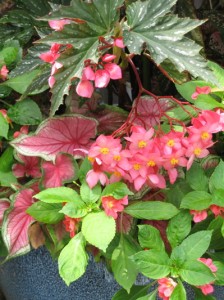
Fancy begonia, caladium and Fusion impatiens make a shade portrait in pink
Five wonderful houseplants for container use are asparagus fern (Asparagus densiflorus, usually ‘Sprengeri’), Southern maidenhair fern (Adiantum capillus-veneris), polka-dot plant (Hypoestes), peace lily (Spathiphyllum) and Schefflera. The first two will add a feathery, delicate texture to your container combinations, while I often use the last two as solitary specimens filling an entire container on their own.
Peace lily is one of the very best performng plants for very low light situations because it has attractive, glossy, lance-shaped leaves in profusion and it produces showy white flowers continuously. Schefflera comes in a gold-variegated form made all the more attractive by the fact that no two leaves have the same coloration. As an added benefit, both can be overwintered easily in a bright spot indoors and then returned to outdoor containers year after year. The lovely Southern maidenhair fern, in contrast, needs such high humidity during the winter months that I simply discard it in fall and buy new in spring.
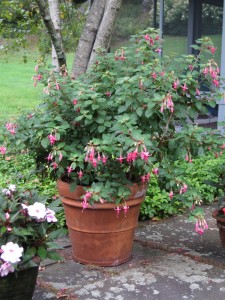
Three Fuchsia 'Mrs. J.D. Fredericks' fill a pot beautifully on their own
In light shade, and still considering foliage plants, try tropicals such as Alocasia and Colocasia. Depending on the selection, both have the potential to get quite large, so generally speaking these will be choices for larger containers. They’ll give you a lushness that will stand out in a northern landscape.
For a similarly tropical look but a naturally more compact habit, you can’t beat Caladium and Syngonium. Few people seem to know the latter plant, which is a caladium lookalike, but it’s usually sold as a houseplant. The most common form has mottled, apple green leaves with a fresh appearance. Caladiums can range from the fairly subtle to the almost garish. ‘Candidum’ types have a tasteful, green-and-white simplicity, while others are heavily splashed with bright red and pink. (Click here to see a number of containers featuring several of the tropicals mentioned above.)
And of course I can’t neglect to mention coleus (Solenostemon). In the north, most coleus actually need brighter conditions than their reputation suggests, but they’re great plants for spots with morning sun or bright but indirect light. Some of my favorites are ‘Kingswood Torch’, ‘Festive Dance’ and ‘Butter Cream’.
The selection of flowering plants that will bloom all summer in northern shade is slim. For lighter shade, you can get away with fuchsias (I recommend two upright types: orange ‘Gartenmeister Bonstedt’ and pink ‘Mrs. J.D. Fredericks’—see above) and trailing wishbone flower (Torenia). The Summer Wave series of torenias will produce a waterfall of flowers in shades of purple, blue, rose and even pale yellow.
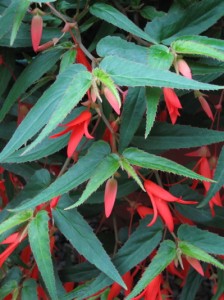
Begonia boliviensis 'Bonfire' trails to produce cascades of brilliant flowers
I mentioned that many perennials also make great container plants, with the added benefit of being able to overwinter them in the ground outdoors and then replant them in your containers in spring. You might even find that they overwinter in your containers just fine, eliminating that extra step.
Virtually any hardy fern that’s the right size and shape for your container would be an excellent choice for shade. Hostas, too, are a good choice no matter the size of your container because there are hostas ranging from miniatures to monsters.
The drapey dead nettles (Lamium) such as ‘White Nancy’ will provide both flowers on and off throughout the summer and good frosty foliage.
Finally, many selections of the perennial Heuchera (coral bells) have been introduced in the past few years with mouthwateringly beautiful foliage. Tantalizingly, selections in the Dolce series are all named after foods! ‘Key Lime Pie’, ‘Peach Melba’ and ‘Blackcurrant’ will spice up your shade containers with colors to rival those of any flowers.
A Spring Thing: Flowers in the Shade
May 31, 2009 by admin
Filed under Garden Design, Shade Gardening
Here we are at the start of June. By the time summer arrives in three weeks, the majority of perennials in northern shade gardens will already have finished blooming. Is that surprising? You may never have realized it, but most shade tolerant perennials bloom in spring.
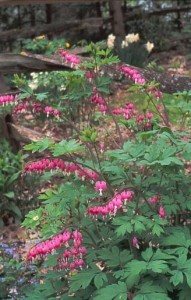
The dangling pink hearts of Dicentra spectabilis are just a memory by the start of summer.
Think about it: hellebore, lungwort, violet, nodding mandarin, epimedium, Solomon’s seal, old-fashioned bleeding heart, most primroses, globeflower, Siberian bugloss, twinleaf, woodland phlox and many other shade standards are already done flowering. False Solomon’s seal, rodgersia, columbine, spotted geranium, bigroot geranium and mayapple are in bloom now, but they’ll be finished by late June, too. Foamflowers are fading (although if deadheaded they’ll put up more flower stalks), and the fruits of baneberry and goldenseal are already fattening up! Yup, flowers in the shade are mainly a spring thing.
What’s left to please the eyes of shade gardeners through the coming months? Goatsbeard, astilbe, hosta, bugbane, Japanese anemone, toad lily and woodland aster are all yet to come. There are more, of course, yet the fact remains that most shade perennials bloom very early in the year. I’d guesstimate 75% of them have wrapped up their flowering by the summer solstice.
There’s a good reason for that, of course. We tend to forget that plants don’t flower to please us. They have their own agenda: reproduction.
In our mostly deciduous temperate forest, the woodland is a full sun environment from November through April when the leaves aren’t on the trees. Most of that time, it’s too cold for perennials to grow, but in March and April, it’s just warm enough for them to shoot up quickly and do energy intensive things like flowering and setting seed while there’s plenty of sunlight to fuel the process. When the trees leaf out in May, many woodland perennials are winding down and looking forward to doing what we all would do if we could get away with it: lounging about all summer.

The best foliage plant ever? Hosta.
The tendency of woodland plants to flower in spring is the main reason why shade gardeners are often advised to stop focusing on flowers and instead rely heavily on exceptional foliage plants: ferns, hostas, sedges, and variegated plants such as (to name just one example) Brunnera macrophylla ‘Variegata’. Flowers will come and go in weeks, but foliage is season long.
Annuals can also help keep color going through the warm months, but the choices for shade in the north are severely limited. Begonias and impatiens are two obvious answers, and they’re readily available at low cost. Gardeners who have grown bored with wax-leaf begonias can try the dragon-wing types for some variety. These grow larger than wax-leaf begonias, are extremely floriferous and make more of an impact, but they also cost more since they aren’t available in 6-packs but have to be purchased in 4-inch pots.
Caladiums are another great choice for summer color in shade gardens, although once again the color is coming from leaves, not flowers. Caladiums are not cold hardy in the North and won’t survive winter in the ground, but they can be dug and stored, dormant, and regrown the following year if you have a bright, warm spot to start them indoors beginning in February or March. Be sure not to put them in the garden too early because they are very sensitive to cool nightime temperatures. Even here in southern New England, I’ve learned not to plant them outdoors until the first week of June. If you do get ahead of yourself with caladiums and they get whacked by an extra-cold night, they should spring back quickly as the weather warms even if their foliage dies back completely in the interim.
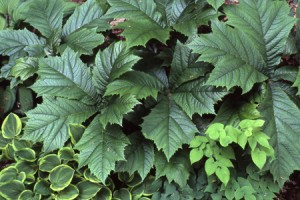
After their flowers have faded, rodgersia and epimedium leaves will continue to bring beauty to the shade garden.
Don’t forget that lots of those spring blooming shade plants I mentioned earlier also have great foliage that will contribute to the beauty of your garden right up until the first frost. Rodgersia, epimedium, hellebore, Solomon’s seal and twinleaf are just a few examples of plants that would be worth growing even if they didn’t flower! So, when designing your shade garden, consider each plant’s total contribution to the effect through the whole growing season, not just the loveliness of its flowers, its most ephemeral aspect.
Breathtaking Bluebells
April 3, 2009 by admin
Filed under Shade Gardening, Spring Bloomers, Spring Ephemerals
Virginia bluebells (Mertensia virginica) are nothing less than the royalty of spring ephemerals. Large, showy, and colorful, they put on one of the very best spectacles of any spring blooming plant, with all the rich costuming you’d expect in the court of a queen.
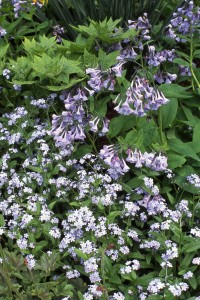
A May mêlée of Virginia bluebells and forget-me-nots
Virginia bluebells break ground very early in spring. Their tightly furled leaves look like tiny burgundy cabbages when they first emerge, but as they grow they quickly morph into medium green, fleshy oblongs that resemble the leafy green vegetable sorrel. Seemingly in no time they produce profuse clusters of dangling blue bell-shaped flowers on 18″ stems, blooming for several weeks in May. (They also come in a white-flowered form that is uncommon but possible to find.) Once flowering ceases, and almost before you have time to notice, they close up shop. Their leaves yellow rapidly, and the plants have gone completely dormant by mid June. They’ll spend the remainder of the year as inscrutable, seemingly dead but really just dormant roots nestled just below the soil surface. Incredibly, their entire aboveground life cycle is barely two months long.
The sheer rapidity of their growth and “demise” along with their large size and showiness make Virginia bluebells very border friendly. Their leaves do not need to hang around the garden for months to store enough energy to ensure flowering the following year. They put on their spectacular display and then vanish—a gardener’s dream!
Virginia bluebells are excellent interplanted with other blue-flowering plants such as perennial woodland phlox (Phlox divaricata). This phlox flowers just as the bluebells fade, so the segue from one to the other is seamless, and because the phlox spreads into a non-competitive groundcover, the bluebells will continue to arise through the mat of phlox foliage year after year. Biennial forget-me-not (Myosotis sylvatica) also makes a great companion, as shown in the photo above.
Virginia bluebells’ sky blue flowers are also an effective counterpoint to yellow daffodils. Gardeners with borders in both sun and shade can take best advantage of this artful duo, planting the sunny areas with clumps of daffodils and the shady ones with masses of bluebells. The result will be breathtaking!
Another natural companion is old-fashioned bleeding heart, whose brilliant pink or clean white flowers reach their peak simultaneously with those of Virginia bluebells, although the latter plant will go dormant months before the former. If you try this combination, use hostas, ferns or other late-emerging plants to fill in the areas occupied by the bluebells in May.
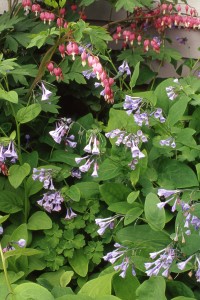
Bluebells and bleeding heart make a natural garden combination
Virginia bluebells spread readily by seed, moving outward from an original planting at a speed of a foot or two a year. In autumn, be careful working in the parts of your garden where bluebells are established, since it is so easy to dig into and accidentally destroy dormant roots at that time of year.
It’s not too late to have Virginia bluebells this year. Nurseries often stock them in April and early May since they’re one of the few plants that can be sold in full bloom at such a chilly time of year.
Sun/Shade needs: Half sun to moderately deep shade; full sun with adequate moisture
Hardiness: Zone 3
Size: 12-18″ tall; 8″ wide
Native status: Native to most of eastern North America, but not all of New England
Bloom times and other life cycle stats are accurate for northwest Connecticut. In milder areas all aspects of a plant’s life cycle may occur earlier in the year, and in colder areas, later.
March, 2010: Update! The good folks at GardenSMART took a shine to this article and reprinted it at their website. You’ll find this post (and many other interesting items) in the Articles section.
Signs of Spring
March 25, 2009 by admin
Filed under Shade Gardening, Spring, Spring Bloomers, Techniques
At 7:44 AM on March 20 the Sun crossed the celestial equator heading north. In common parlance, that translates to: spring is here!
It didn’t take long for wildlife to answer the call. Two days later, I awoke to the sound of a red-breasted robin singing at 6:00 AM. The cardinals have been getting redder and redder and going great gangbusters for weeks with their impressions of distant car alarms, but they’re here year round. The robin was the first migrant I’d heard stretch its vocal cords this year.
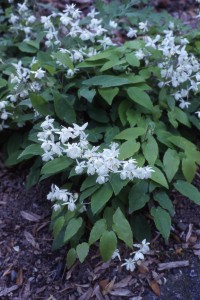
Epimedium x youngianum 'Niveum' in its April glory
While the robins celebrated spring by completing the last leg of their long journey, I was out in the garden performing one of the first jobs necessary to the season: uncovering my epimediums. (They have a common name—bishop’s hat—but somehow I just can’t bring myself to use it. They’ll always be epimediums to me.)
Along with hellebores and lungworts, epimediums start growing actively in March long before many of us have gotten out to remove the leaves that blew into the garden late last year after the rake had been put away for its long winter’s nap. (Or was it the gardener determined to nap? Tools can be convenient excuses…)
If you live on a lot with many trees, no matter how much you raked and blew last fall, you might find a lot of leaves staring up at you from the garden when the snow melts. Many plants can benefit from that cozy little coverlet, but for others it’s a problem.
While hellebores and lungworts are sturdy plants that can withstand the inevitable manhandling that occurs when you peel away sopping wet mats of oak leaves, epimediums are delicate little things with fragile stems all too easily snapped off. Wait even a week too long to clear them of leaf litter, and you may not be able to do it without surgical tools. (I exaggerate, but not by much.)
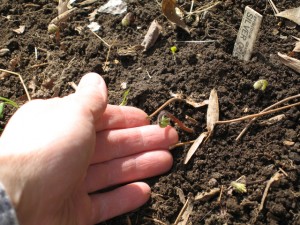
New epimedium growth under the leaf litter in March
At left is a picture of a curled epimedium flower stalk taken on March 20 just after being uncovered. This happens to be a patch of E. ‘Silver Queen’, a large-flowered white variety. In just a few weeks, it will put on a display to rival the extravagant bloomer E. x youngianum ‘Niveum’ shown in the picture above.
As careful as I tried to be when I removed the errant leaves, I wasn’t careful enough. Below left is a photograph of a stalk that I clumsily damaged. It takes almost no force to snap the top off these little guys, and that’s one spray of flowers less for me, the bees and everyone else this spring.
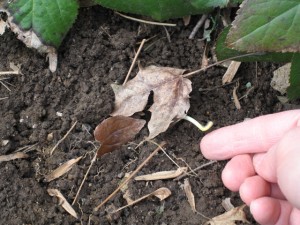
Epimedium stalk accidentally broken off
Some epimediums have fairly persistent stalks that don’t disintegrate on their own over winter. While you might not have to groom ‘Niveum’ at all, most others aren’t as accommodating. E. x perralchicum ‘Frohnleiten’ has perhaps the most evergreen leaves of any epimedium. This is both a plus and a minus. In snowless winters, they’re something to look at. But snow or no snow, in spring they’ll require cleanup. A pair of hedge clippers is the tool for this task. They do the job quickly and with all the precision required. You could just leave last year’s foliage alone, and new growth would come up through it and eventually conceal it, but most epimediums look better with a figurative shower and shave.
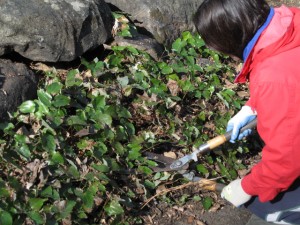
Shearing back epimediums in mid March
Unless you mulched last autumn, have some light, compost-based mulch handy to spread on your epimediums as soon as you uncover them. Otherwise, the soil around them will dry out quickly. At this time of year the sun is surprisingly intense, although most of us aren’t aware of it because air temperatures haven’t climbed yet. But I’ve learned that when I come out of my winter semi-hibernation and start working outdoors up to eight hours a day in March and April, I’d better wear sunscreen! New growth of shade-loving plants should also have some protection, not from the sun itself, but from the soil dryness it can cause.
Of course, even if I didn’t remove the leaves from my epimediums, they’d grow right up through their brown blanket and bloom anyway. But I prefer the look of a clean bed with a dressing of compost as a nice backdrop. Knowing that the job of removing those leaves without damaging the epimediums becomes harder with each passing day is enough incentive for me to get outside in mid March no matter what the weather. Ironically, as intolerant as they are of mishandling, fresh new epimedium growth will have no problem withstanding freezing nights.
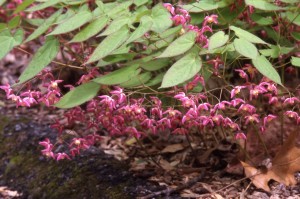
The reason for the work of the season. Darn—where'd that leaf come from?!
Spring Blooming Shade Plants: Hellebores
March 18, 2009 by admin
Filed under Perennials, Shade Gardening, Spring Bloomers
In a typical year, hellebores will be the first ornamental perennial to bloom in the Northeast. Although there are several species that can be grown in this region, especially in milder areas such as the coast and the lower Connecticut River Valley, one of the hardiest remains my favorite: Helleborus x hybridus (formerly and sometimes still known as Helleborus x orientalis).
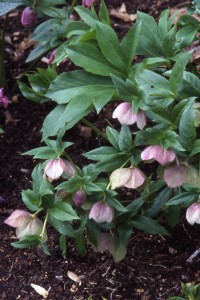
Helleborus x hybridus
Here in northwest Connecticut, hellebores send up their flower buds first, in March, before their leaves unfurl. As the month goes on, these succulent and tender looking shoots grow taller and taller, until they finally open up around April 1 to reveal clusters of 2″-wide, pendant blossoms. The species H. x hybridus is quite variable, with a range of subtle flower colors including creamy white, apple green, pale pink and burgundy. Its flowers often have striking speckled markings and prominent yellow anthers that are showy for about a week until the stamens fall off.
At first, hellebore flowers look a bit undressed because the plant’s leaves don’t come along until a few weeks later. When they do make their appearance, however, they are exceptionally attractive—leathery, glossy, palmate (arranged like fingers around the palm of a hand) and semi-evergreen.
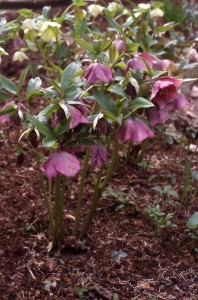
Hellebore flowers emerge before leaves
Everything about hellebores is long lasting. Instead of dropping off after 2-3 weeks, hellebore flowers slowly fade to a pale green or buff color in much the same way hydrangea flowers do. They look good (although subdued) right up to the point when the seeds mature and are dispersed, usually in the latter half of June. Deadhead them before that point unless you want seedlings the following spring. In most gardens, the leaves will remain disease free and unblemished all season long, and will still be looking good when the first snow flies.
Shade tolerance: High
Hardiness: Zone 5; other species may differ
Size: Medium sized, with a height and spread of 15-18″
Native status: non-native to any part of North America
Growing Tips
- Don’t cut back hellebore foliage in fall, even if you clean up the rest of your garden then. Why? Hellebores come up so early in the year, they are subject to damage from late frosts. These frosts won’t kill the plants, but they will kill the flower buds. As the plant’s shoots begin to emerge from the ground, last year’s leaves will provide some protection. After the new shoots have grown taller than last year’s leaves, you can groom them, cutting off the old foliage at ground level. Be careful not to accidentally cut off new growth—it’s easy to do. For a few more weeks after you groom them, it’s a good idea to keep some pine boughs or an equivalent handy to gently arrange over the new growth at night if a hard frost is in the forecast.
- Hellebores have to be several years old before they are mature enough to flower. A nursery plant in a 5-pint pot is probably only two years old, so don’t be surprised if it doesn’t flower its first (or even second) year in the ground. As long as the plant grows well and looks healthy, flowering should start when the plant is ready. A plant that fills a one-gallon pot should be old enough to flower its first spring after planting.
- H. x hybridus is often sold in a mix of undifferentiated colors. In other words, if the tag in the pot with your plant does not specify a flower color, but just says H. x hybridus, it could be any of the flower colors listed above. There’s no way to know which color you’ve got unless you buy the plant in bloom very early in the season and the plant is old enough to be blooming in the first place. In recent years, some growers have also offered hellebores in designated colors. I like the way the mixed colors look in the garden when hellebores are massed, but gardeners with color-theme gardens might prefer to purchase all of one kind.
- Hellebores have no special needs, but they don’t like excessive moisture. If put in exceedingly dank locations or planted in soils that drain poorly, rot of the crown may result.
- Hellebores self-sow moderately. Their seeds are large and heavy, so they don’t usually travel very far. If you don’t deadhead your plants before they drop their seeds, you’ll probably find a “skirt” of seedlings around their feet in spring. Move these to a nursery bed to mature or give them away to friends.
Bloom times and other life cycle stats are accurate for northwest Connecticut. In milder areas all aspects of a plant’s life cycle may occur earlier in the year, and in colder areas, later.

